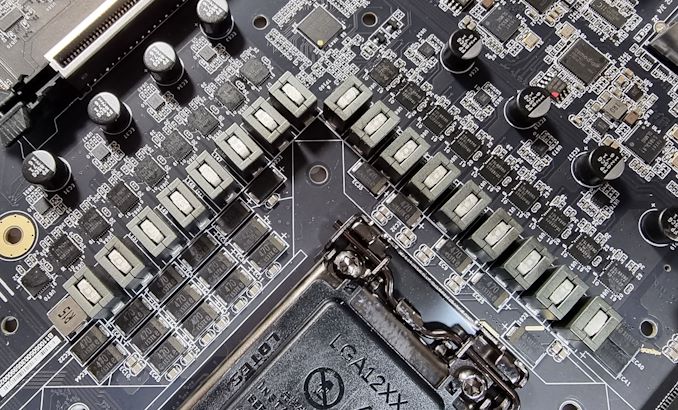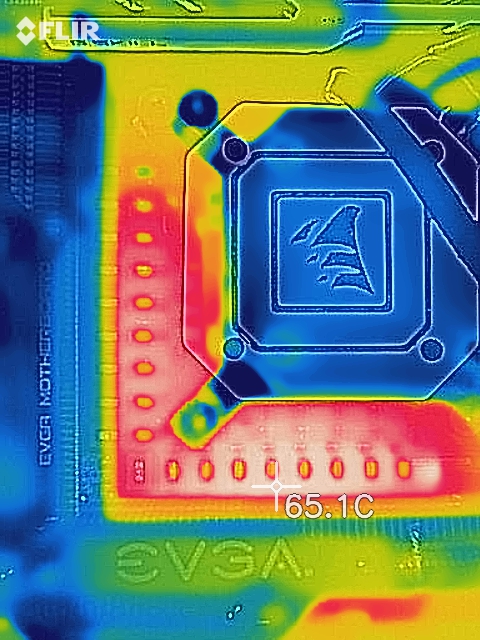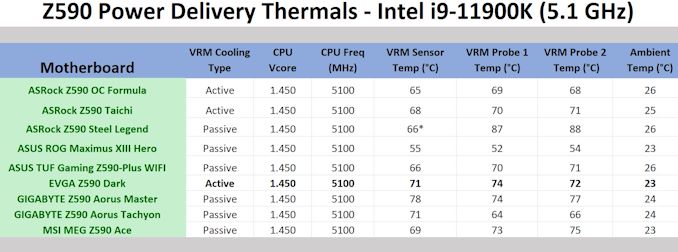The EVGA Z590 Dark Motherboard Review: For Extreme Enthusiasts
by Gavin Bonshor on October 15, 2021 9:00 AM ESTPower Delivery Thermal Analysis
One of the most requested elements of our motherboard reviews revolves around the power delivery and its componentry. Aside from the quality of the components and its capability for overclocking to push out higher clock speeds which in turn improves performance, is the thermal capability of the cooling solutions implemented by manufacturers. While almost always fine for users running processors at default settings, the cooling capability of the VRMs isn't something that users should worry too much about, but for those looking to squeeze out extra performance from the CPU via overclocking, this puts extra pressure on the power delivery and in turn, generates extra heat. This is why more premium models often include heatsinks on its models with better cooling designs, heftier chunks of metal, and in some cases, even with water blocks.

The 21-phase power delivery on the EVGA Z590 Dark (operating in 8+1+1 with doublers for the CPU VCore)
Testing Methodology
Our method of testing is if the power delivery and its heatsink are effective at dissipating heat. We do this by running an intensely heavy CPU workload for a prolonged method of time. We apply an overclock, which is deemed safe and at the maximum that the silicon on our testbed processor allows. We then run the Prime95 with AVX2 enabled under a torture test for an hour at the maximum stable overclock we can, which puts insane pressure on the processor. We collect our data via three different methods which include the following:
- Taking a thermal image from a birds-eye view after an hour with a Flir Pro thermal imaging camera
- Securing two probes on to the rear of the PCB, right underneath CPU VCore section of the power delivery for better parity in case a probe reports a faulty reading
- Taking a reading of the VRM temperature from the sensor reading within the HWInfo monitoring application
The reason for using three different methods is that some sensors can read inaccurate temperatures, which can give very erratic results for users looking to gauge whether an overclock is too much pressure for the power delivery handle. With using a probe on the rear, it can also show the efficiency of the power stages and heatsinks as a wide margin between the probe and sensor temperature can show that the heatsink is dissipating heat and that the design is working, or that the internal sensor is massively wrong. To ensure our probe was accurate before testing, I binned 10 and selected the most accurate (within 1c of the actual temperature) for better parity in our testing.
To recreate a real-world testing scenario, the system is built into a conventional desktop chassis which is widely available. This is to show and alleviate issues when testing on open testbeds, which we have done previously, which allows natural airflow to flow over the power delivery heatsinks. It provides a better comparison for the end-user and allows us to mitigate issues where heatsinks have been designed with airflow in mind and those that have not. The idea of a heatsink is to allow effective dissipation of heat and not act as an insulator, with much more focus from consumers over the last couple of years on power delivery componentry and performance than in previous years.
For thermal imaging, we use a Flir One camera to indicate where the heat is generated around the socket area, as some designs use different configurations, and an evenly spread power delivery with good components will usually generate less heat. Manufacturers who use inefficient heatsinks and cheap out on power delivery components should run hotter than those who have invested. Of course, a $700 flagship motherboard is likely to outperform a cheaper $100 model under the same testing conditions, but it is still worth testing to see which vendors are doing things correctly.
Thermal Analysis Results

We measured 65.1ºC on the hottest part of the CPU socket during our testing
The EVGA Z590 Dark is using a large 21-phase power delivery system, which is actually operating in an 8+1+1 configuration. The CPU VCore section consists of sixteen Renesas ISL99390 90 A smart power stages operating in an 8-phase layout with eight Renesas ISL6617 doublers, while the SoC section is using one Renesas ISL99360 60 A power stage. Keeping the power delivery cool is a large pair of heatsinks that are interconnected by a single heat pipe which also connects it to the chipset heatsink. To further aid in heat dissipation, EVGA includes two 40 mm cooling fans that vent hot air out via ventilation holes in the pre-attached rear I/O shield.
Focusing on the thermal performance of the EVGA Z590 Dark's power delivery, it put in a solid performance despite not operating as cool as some other Z590 models we have tested. It trades blows with the equally adept GIGABYTE Z590 Aorus Tachyon, but the EVGA board does have the added advantage of an actively cooled VRM design. We observed temperatures of 71°C from the integrated thermal VRM sensor, with temperatures of 74°C and 72°C respectively from our pair of K-type thermocouples.
Overall the EVGA Z590 Dark does perform well, but we would have expected better given the pair of cooling fans and the large heatsink design, as well as the large design of the power delivery.











27 Comments
View All Comments
gavbon - Saturday, October 16, 2021 - link
Value is all relative to what a user is willing to spend. For extreme overclocking, that's dependant on the qualityAlistair - Friday, October 15, 2021 - link
Quick! Buy it 2 weeks before it is obsolete! Hurry! ;)Silver5urfer - Friday, October 15, 2021 - link
Obsolete ? LGA1700 ADL is going to be a generation first product on DDR5 with Gear 4 and Gear 2, on top of new trash cores shoved in because of high power consumption. Plus a basic PCIe5.0 for GPU X16 only. Yeah more DMI and more lanes but questionable Intel Hardware Scheduler on top of the big little BS first adoption on top. Plus the added cost for all the new tech.If we follow the leaks ADL barely matches Zen 3 in SMT and perhaps in ST boost how it translates to real world ? Gotta see, RKL was also like that but came at huge power spike and not much in SMT. This new ADL has inferior cores going to magically beat in real workloads ? Nah.
Nope this platform is not Obsolete only issue is PCIe NVMe SSD slots aren't there and must use PCIe slot and RAID them. If used with 10th gen then PCIe3.0 will be a negative on the GPU lane when used with NVMe SSDs.
Alistair - Friday, October 15, 2021 - link
You can buy it using DDR4 and it is in no way inferior, if you don't want DDR5. The new big cores are just better than Rocket Lake big cores, so who cares about the small cores, those are just extra. With Intel you can even disable any cores you don't want. Why are you comparing to AMD when we are talking about Z590 being obsolete vs the latest Intel, AMD has nothing to do with my comment. A lot of funny responses in your comment.Silver5urfer - Friday, October 15, 2021 - link
It's not obsolete is the fact gauging by the performance it offers. The fact that AMD was mentioned is because on how RKL was compared to it and had ST advantage but nothing in SMT and huge power draw.Small cores no one cares ? Are you drunk lol. Intel is screaming from their chest that these 8x Atom trash are better than SMT cores AND the fact on how the Cinebench leaks showed it barely reaches to AMD's top SKU in the same tests. And you think disabling those small cores is going to net you the performance boost that Intel is claiming, what a pathetic joke. Those cores are needed if you disable you lose SMT Multicore advantage. Period. AND finally DDR4 is Gear 2 by default there was a latest leak saying Gear 1 is maxed out at 3600MHz probably similar or could be worse than RKL IMC.
You took the AMD and other aspects and discarded everything related to being a new platform on top of the extra costs, done with your kind of garbo useless replies.
amnesia0287 - Friday, October 15, 2021 - link
Assuming anyone will be able to actually find them in stock. I wasn’t under the impression intel had solved the silicon shortages.Wrs - Sunday, October 17, 2021 - link
Oh come on, Z590 is at higher risk of obsolescence than a typical chipset. Every CPU supported is 14nm. You could be stuck between the power hungry RKL and the soon to be two generation lag of Comet Lake. Both already have problems comparing to Ryzen.LGA1700 should offer you the ability to reuse ddr4. The number of technologies being added is what obsolescence is about, no? The only thing to save Z590 from obsolescence is if ADL is trash, and you simply don't know that, not from the public leaks.
Flying Aardvark - Sunday, October 17, 2021 - link
That makes no sense. RKL is the fastest gaming CPU where it counts, minimum frames per second / 99th percentile. https://www.tomshardware.com/reviews/best-cpus,398... Take a look for yourself. Who cares if it's 14nm? Larger process nodes have their advantages as well. Performance is what matters. If you're looking to save on energy, buy yourself a tablet. The only thing obsolete is whatever you're running in your rig today instead. Ryzen has plenty of problems, you're just not informed. Stay salty, poor boy.Wrs - Sunday, October 17, 2021 - link
Obsolescence is about what's around the corner, not what you have today. I just think buying any Z590 today is asking for buyer's remorse. Around the corner, we're expecting expanded cache Ryzens for AM4 - which may not be much except for gaming - and ADL on Z690. ADL consists of two new cores on a finer process (I consider it coequal with Zen 3's 7nm), translating to a higher overall core/thread count and cache, and ITD with all its potential game optimizations. Unless ADL has a poor showing or developers don't support ITD, won't ADL make Z590 suddenly feel lackluster? It could be a mild Pentium 4 moment.It's true that RKL holds pole position for most games right now. It's just that the edge over a 5800x is really small, the cost of that power budget is substantial, and many of us weigh other workloads too, including multitasking while gaming.
Silver5urfer - Monday, October 18, 2021 - link
As a platform probably yes because of only I/O - PCIe3.0 for CML and RKL gettin Gen 4 but at 8C max and insane ABT power spiking and heat. In terms of performance not yet. ADL is a brand new platform and with questionable core design it's already having a lot of news around DRM, Application optimizations and etc. Why should I pay for beta testing a product ? Esp when the DDR5 is so new and PCIe5.0 barely has any effect and the whole socket longevity along with Intel Thread Director drama and Win11 shenanigans ??Intel clearly lost their way. RKL was the first sign of that, IMC massively downgraded on that. With ADL DDR4 is not going to run at 4000MHz C15. It's not going to happen. The leaks show max of 3600MHz just like AMD, AM4 platform has a TON of issues, I was on the verge on pulling a trigger on Crosshair 8 Dark Hero but the USB drop out, WHEA issues, random PCIe issues, million AGESA updates. FCLK instability all these are there some of them only if you push the CPU but what's the point in buying a 16C or 12C processor and shoving it in an OC capable high VRM mobos likes of Aorus Master or Xtreme etc or even the X570 DARK and run it on all stock ?
All of these compound to one thing per my analysis, CML / RKL LGA1200 is a better mature platform to put money in for the next 5 years of it's life.